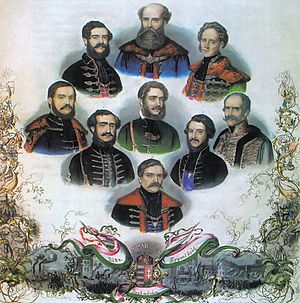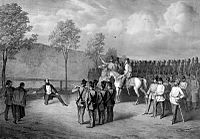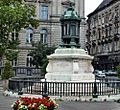Lajos Batthyány facts for kids
Quick facts for kids
Lajos Batthyány
de Németújvár
|
|
|---|---|
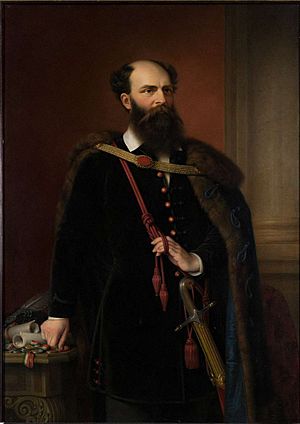 |
|
| 1st Prime Minister of the Kingdom of Hungary | |
| In office 17 March – 2 October 1848 |
|
| Monarch | Ferdinand V |
| Preceded by | position established |
| Succeeded by | Lajos Kossuth |
| Personal details | |
| Born | 10 February 1807 Pozsony, Kingdom of Hungary, Austrian Empire (present-day Bratislava, Slovakia) |
| Died | 6 October 1849 (aged 42) Pest, Kingdom of Hungary, Austrian Empire (present-day Budapest, Hungary) |
| Resting place | Kerepesi Cemetery, Budapest |
| Nationality | Hungarian |
| Political party | Opposition Party |
| Spouse | Antónia Zichy de Zics et Vázsonykő |
| Children | Amália Ilona Elemér |
| Signature |  |
Count Lajos Batthyány (born February 10, 1807 – died October 6, 1849) was a very important figure in Hungarian history. He became the first ever Prime Minister of Hungary. He was born in Pozsony (which is now called Bratislava) and later died in Pest (part of modern-day Budapest). He was executed on the same day as the famous 13 Martyrs of Arad.
Contents
Lajos Batthyány's Life and Work
Lajos Batthyány came from a noble family. His father was Count József Sándor Batthyány, and his mother was Borbála Skerlecz. When he was young, his parents divorced. Lajos moved to Vienna with his mother and brother. He had a private teacher, but later went to a boarding school.
Early Years and Education
At 16, Lajos finished boarding school. He then studied at the Academy in Zagreb (now the University of Zagreb, Croatia). In 1826, he spent four years in Italy. There, he became a lieutenant in the army and also earned a law degree.
In 1830, he became a hereditary peer in the Upper House of the Hungarian Parliament. This meant he had a seat in the government. At first, he wasn't very interested in politics.
In 1834, he married Countess Antónia Zichy. They had three children: Amália, Ilona, and Elemér. It is said that his wife encouraged him to take on bigger roles in politics.
A Leader for Change
Batthyány became more involved in politics after 1839. He became the Leader of the Opposition in the Hungarian Parliament. He created a plan to make important changes, called reforms. He even suggested using stenographers to write down everything said in the Upper House.
Batthyány shared ideas with István Széchenyi, another important Hungarian leader. They both believed in improving Hungary's economy. Batthyány helped promote horse breeding and other animal farming. He also supported growing silkworms by planting many mulberry trees.
He worked with Lajos Kossuth from 1843. In the 1843–1844 parliament, Batthyány was the main Leader of the Opposition. He spoke out against the Habsburg monarchy's policies.
After parliament ended, Batthyány moved to Pest. He became chairman of the Central Election Office in 1845. He also helped start the Védegylet, a society that promoted Hungarian products. In 1847, he became the first president of a new group called the Maverick Party.
Batthyány strongly supported Kossuth, both with his words and with money. Kossuth became a representative in parliament in 1847. Batthyány led the opposition in the Upper House, while Kossuth led it in the Lower House.
Hungary's First Prime Minister
Batthyány was part of a group that went to meet Emperor Ferdinand I of Austria. They wanted Hungary to have its own government that was in charge of its own land. On March 17, 1848, the Emperor agreed. Batthyány then formed the first Hungarian government.
The new government's first job was to create new laws for the revolution. These laws were approved on April 11, 1848. Hungary faced many challenges at this time. Batthyány's most important task was to organize the army and local government. He made sure that Austrian soldiers in Hungary followed Hungarian laws. He also started to create an independent Hungarian Revolutionary Army. He even served as the Minister of War for a time.
Batthyány was a skilled leader. He tried to find a balance between the Austrian monarchy and those who wanted Hungary to be completely separate. He believed in a constitutional monarchy, where the king's power is limited by a constitution. However, the Emperor was not happy with his actions.
In August 1848, Batthyány and Ferenc Deák asked the Emperor to stop Jelačić, who was planning to attack Hungary. Batthyány even offered Jelačić that Croatia could peacefully separate from Hungary. But his efforts failed. Jelačić and his army invaded Hungary on September 11, 1848.
Because of this, Batthyány and his government resigned. However, at the request of Archduke Stephen, Palatine of Hungary, Batthyány became Prime Minister again. On September 13, Batthyány called for a rebellion. But the Palatine resigned and left Hungary.
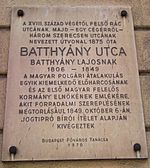
The Emperor did not recognize the new government. He also said Batthyány was no longer in charge. He appointed Count Franz Philipp von Lamberg to lead the Hungarian army. But Lamberg was killed by rebels in Pest. Batthyány went to Vienna again to try and find a peaceful solution with the Emperor.
Batthyány worked quickly to organize the Hungarian Revolutionary Army. This new army defeated the Croatians on September 29 at the Battle of Pákozd.
Batthyány realized he could not reach an agreement with the Emperor. So, on October 2, he resigned again. He also gave up his seat in parliament.
After Resignation
As a regular soldier, Batthyány joined József Vidos' army. He fought against General Kuzman Todorović. On October 11, 1848, he fell off his horse and broke his arm.
After he recovered, Batthyány was again elected as a politician. He did not want the Parliament to move to Debrecen. Because of his idea, Parliament sent a group, including Batthyány, to meet with General Alfred I, Prince of Windisch-Grätz. They wanted to know the general's plans. But the general refused to meet with Batthyány.
On January 8, 1849, Batthyány returned to Pest. He was captured at the Károly Palace and put in prison. As the Hungarian army got closer to Pest, Batthyány was moved to other cities. The Hungarians tried to rescue him many times, but Batthyány asked them not to. He believed his actions were right and that the court had no power over him.
Execution
On August 16, 1849, a military court decided Batthyány's fate. At first, they wanted to take his belongings and send him to prison. But under pressure from Prince Felix von Schwarzenberg and the Austrian Empire, they sentenced Batthyány to death.
Batthyány was brought to Pest. People hoped that General Julius Jacob von Haynau would show him mercy, but Haynau sentenced him to be hanged. However, due to a last-minute change, the court decided he would be executed by firing squad instead.
Batthyány knelt in front of the firing squad. His last words were: "Éljen a haza! Rajta, vadászok!" ("Long live my country! Come on, huntsmen!").
Batthyány's funeral was held in the city center. His remains were later moved to a newly built mausoleum in the Kerepesi Cemetery in 1870.
Works and Legacy
Batthyány's speeches in parliament were written down in newspapers and diaries of the time. He also wrote an essay about growing sugar beets.
Monuments and Memorials
- Batthyány's Mausoleum in the Kerepesi Cemetery in Budapest, Hungary.
- A famous portrait of Batthyány was painted by Miklós Barabás.
- The Batthyány Örökmécses (a monument) in Budapest.
- Batthyány Square and Batthyány Street in Budapest are named after him. A statue of Batthyány was put up in Batthyány Square in 2008.
- The Batthyány Lajos Trust was founded in 1991 to honor him.
- A special medallion was made in 1994 by the Batthyány Association.
Images for kids
See also
 In Spanish: Lajos Batthyány para niños
In Spanish: Lajos Batthyány para niños


